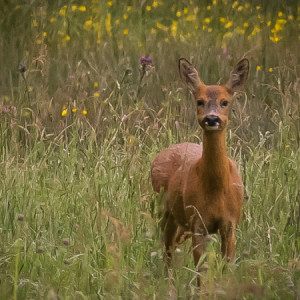A Bit of Ruff
It was difficult to choose what to blip today. A and I went on a walk around Pensthorpe Natural Park today. We came across these Ruff in the Aviary enclosure, many wildlife photographers were pointing their camouflage- covered long lenses at them as they only display these ruffs and collars during courtship, which is a most extraordinary sight (Something I had not seen before). I have included some information about this below for those who may be interested. The extras are of a red squirrel who is part of the conservation breeding programme and a wild female roe deer in the wildlife meadow. A lovely walk, and no rain! Although it's been hammering down again since mid-afternoon.
I've been having a difficult few weeks with migraines and so my blips have been almost non-existent. However, I feel better today so hope to get back to regular blipping and commenting again.
The Ruff is a wader, remarkable for its unusual courtship plumage and behaviour. The name ruff applies to the species or may be applied to the male only. In spring the 30-cm (12-inch) male acquires a double crest (“cape”) and a collar (“ruff”); these may contain reddish, brown, black, and white feathers in proportions that vary with the individual. (This is the most extreme case of polymorphism known among birds.) The female, called the reeve, is only about 25 cm (10 inches) long and is plain grayish brown, as is the male in winter.
In the breeding season, males gather on a traditional display area (lek), usually a bare hill, and, while the reeves watch, display close together by making short rushes with cape and ruff erect and wings drooping. During the silent courtship dance, males may raise head tufts, leap into the air, bow, crouch, and stand tall. Two social classes of males are evident during the display. Resident males have black, brown, or patterned ruffs. They share their lek territories with subordinate more-conspicuous males that have white ruffs. The lighter subordinate males help attract females to the territories of the resident males. While the aggressive resident male is busy defending his area of the lek, the subordinate male sometimes “steals” copulations with visiting females. This behaviour is genetically inherited along with the coloration of the male.
When a reeve strolls into their midst, the males collapse, quivering, with bills stuck into the ground. Then the female chooses one of the males, usually a resident male. Before mating, she nibbles at the male’s ruff. Alone, she builds a nest, which is well hidden in a shallow depression in marsh grasses, incubates two to four olive eggs, and raises the chicks. Ruffs are extremely dimorphic; the sexes keep apart, even in flocks.



Comments
Sign in or get an account to comment.


